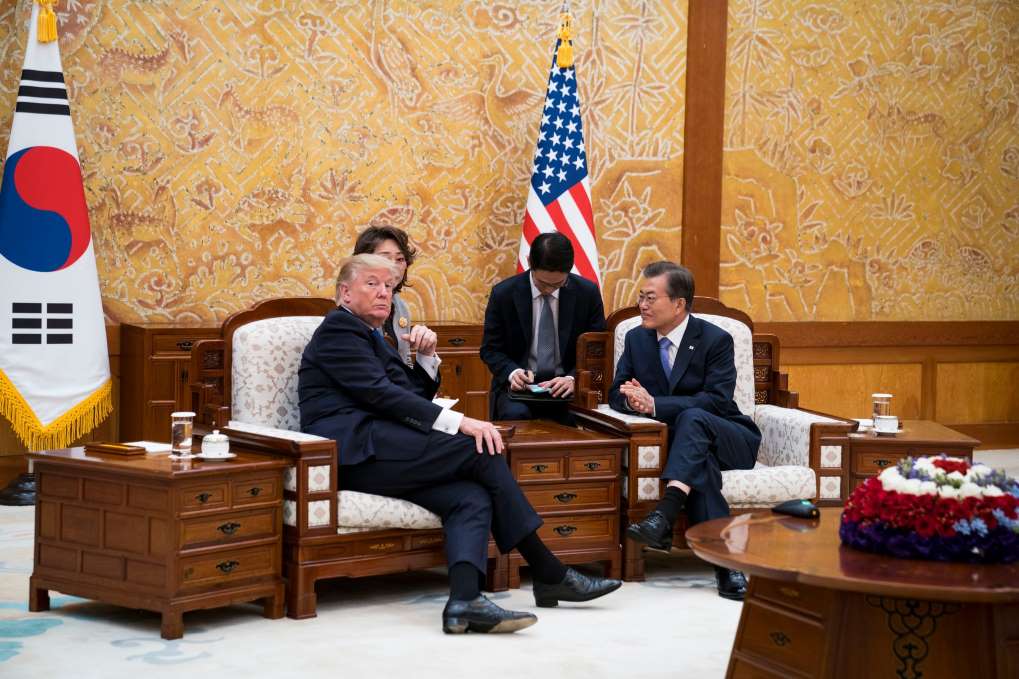November 11, 2017
WASHINGTON, D.C. — President Trump advertised his deal-making prowess during his Asia trip this week, claiming to have struck economic, energy and military trade agreements with Japan, South Korea and China worth billions of dollars.

November 11, 2017
WASHINGTON, D.C. — President Trump advertised his deal-making prowess during his Asia trip this week, claiming to have struck economic, energy and military trade agreements with Japan, South Korea and China worth billions of dollars.

President Trump participates in a bilateral meeting with President Moon Jae-In of South Korea on Tuesday. – Doug Mills/The New York Times
Whatever bill of goods Mr. Trump is selling, his claims require more context.
In the latest claim, issued on Friday, the White House released twostatements saying the United States and China “signed trade and investment deals worth more than $250 billion” while Mr. Trump was in Beijing.
However, the Commerce Department’s breakdown of the $250 billion package includes several items that are not guaranteed to proceed — like an $8 billion natural gas project and $83 billion in shale development projects. Both were agreed to in nonbinding memorandums of understanding.
The Commerce Department’s breakdown also lists a $38 billion agreement for Boeing to supply China with 300 aircraft, which is in line with its 20-year forecast; and $2.2 billion in sales from General Motors to S.A.I.C., a large automaker in China that has a joint venture with G.M.
Earlier, in Seoul, Mr. Trump touted similar deals with South Korea that he said will bring jobs to the United States and reduce the trade deficit. “They’ll be ordering billions of dollars’ worth of equipment, and we’ve already approved some of those orders,” he said in a Nov. 7 joint news conference with President Moon Jae-in.
And in a Nov. 6 joint news conference with Prime Minister Shinzo Abe in Tokyo, Mr. Trump said Japan and other countries were now buying F-35 fighter jets, missiles and other military equipment from the United States “that, frankly, a year ago and two years ago were not.”
“It’s a lot of jobs for us,” Mr. Trump said at the news conference. Shortly afterward, he
My visit to Japan and friendship with PM Abe will yield many benefits, for our great Country. Massive military & energy orders happening+++!
— Donald J. Trump (@realDonaldTrump) November 6, 2017
, “My visit to Japan and friendship with PM Abe will yield many benefits, for our great Country. Massive military & energy orders happening+++!”
Mr. Trump is wrong that those countries purchasing equipment today did not do so “a year ago and two years ago.”
Out of more than three dozen countries that have signed agreements with the United States this year, none were first-time buyers. The United States offered other countries $722 billion worth of arms between 1950 and 2016. That includes $12.6 billion to Japan and $18.1 billion to South Korea during the Obama administration.
In September, Mr. Trump gave “in-principle” and “conceptual approval” for South Korea to purchase missile defense systems and other weapons from the United States. But it is unclear whether South Korea or Japan told Mr. Trump they would buy more American equipment during his visits.
Even so, verbal agreements would represent a very preliminary step in a lengthy process that can take years.
Under the Pentagon’s foreign military sales program, a country interested in American defense equipment must first formally request a potential purchase. The State Department must approve it, and Congress must be notified between 15 to 30 days before the military Defense Security Cooperation Agency can accept the request.
At that point, the United States and the foreign customer sign a letter of agreement, and begin negotiations on price and other details of the order. And finally, production begins — although Congress can block or modify the deal anytime before items are delivered.
So, for now, the dealmaker-in-chief’s claims are “aspirational at best,” said William Hartung, director of the Arms and Security Project at the Center for International Policy in Washington. “Trump can’t just snap his fingers and make an arms sale happen tomorrow.”
The Defense Security Cooperation Agency last notified Congress of intended sales to South Korea — two$70 million orders for missiles — on Jan. 31. The most recent notification it sent regarding sales to Japan, a missiles purchase worth $113 million, was on Oct. 4.
A State Department official declined to comment on potential or pending arms sales before they are notified to Congress, but said the United States is committed to the defense of both Japan and South Korea.
Congress was notified of Japan’s request to purchase 42 F-35’s in May 2012. The first four planes were manufactured in Fort Worth, Texas, but the remaining 38 are being assembled in Japan. That raises doubt about Mr. Trump’s claims that the deal would bring “a lot of jobs for us.”
In a Nov. 8 report in the Japan Times, Japanese Chief Cabinet Secretary Yoshihide Suga appeared to walk back the notion of new purchases from the United States. Instead, he said, Tokyo is following its existing defense procurement plans.
“We’re acquiring equipment for the Self-Defense Forces, as planned in the National Defense Program Guidelines and the Medium-Term Defense Program,” Mr. Suga said. The midterm program, which calls for buying F-35 fighters, guided missiles and Aegis-equipped destroyers through 2018, was approved more than three years before Mr. Trump took office.
Officials in South Korea also countered Mr. Trump’s claims of done deals.
In the Seoul news conference, Mr. Moon said he and Mr. Trump “have agreed to begin the consultations for Korea’s acquisition of such assets.” Marc Knapper, the acting ambassador to South Korea, toldreporters that new arms sales — like Aegis-equipped destroyers and P-8 aircraft — are currently under discussion.
Mr. Knapper also cited an order for F-35 fighters as one of Mr. Trump’s “already approved” orders. Congress was notified of the order of 60 F-35 aircraft from Korea in April 2013, and the two countries signed the agreement in September 2014.
“All of this suggests that there may not be much President Trump can add to the avalanche of arms already in the pipeline,” Mr. Hartung said. “But that won’t keep him from taking credit for deals that were concluded before he took office.”
Courtesy/Source: NY Times
















































































































